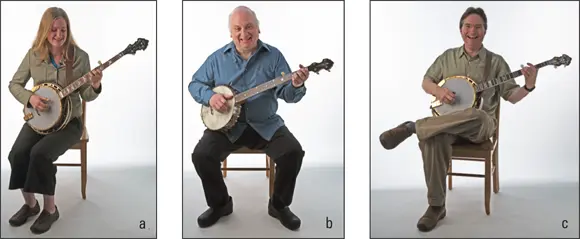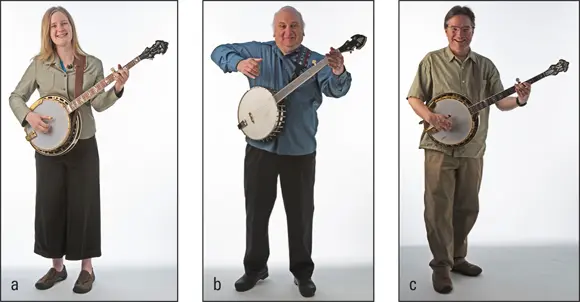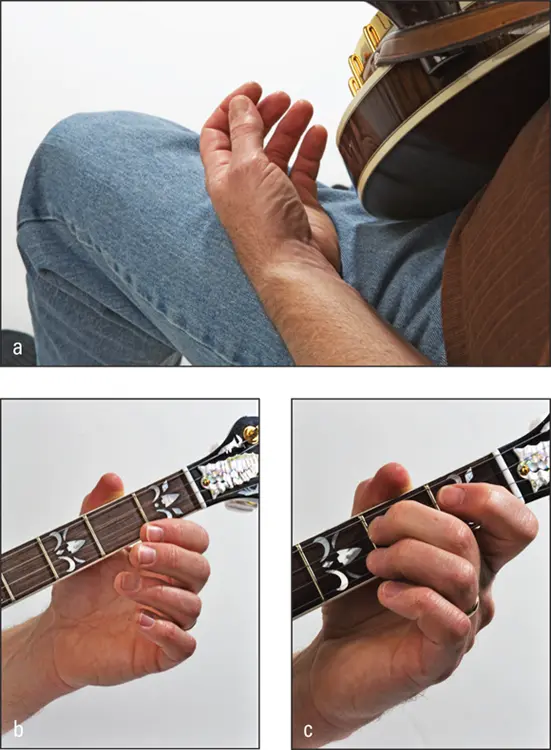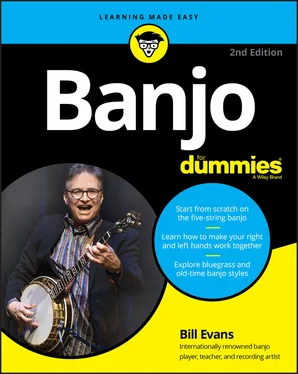You also want to find a chair around the house that allows you to comfortably sit upright, provides you with some back support (if you need it), and allows your arms to move freely (no recliners allowed!). When I'm playing around the house, I like to use an adjustable office chair with the side arms removed. As you sit, position the banjo so that you're able to see the fingerboard and the banjo head, but don't let the banjo be so low in your lap that you have to reach far around the neck to fret with the left hand.
After you've actually started to play banjo, take a look at photos of some of your favorite players and experiment with different neck angles to see what works the best for you. Figure 3-4 shows three different ways of holding the banjo while sitting. Note that the middle player, Jody, rests the banjo on his right thigh and doesn't need a strap at all. Erin (left) and yours truly (right) prefer straps on our heavier resonator banjos.

Photographs by Anne Hamersky
FIGURE 3-4:Erin (a), Jody (b), and Bill (c) show three different ways to enjoy playing the banjo while sitting.
The key to being comfortable while standing with the banjo is to adopt a position that's similar to the position you use when sitting. If you've found a good sitting position (see the preceding section), stand up with the banjo and watch what happens. Try adjusting the strap length so that you have little to no change in the position of the banjo for both your sitting and standing positions.
DON'T LET “DUNLAP'S DISEASE” GET YOU DOWN
If you're in the prime years of your life like me, you may suffer from Dunlap's disease. What's that, you innocently ask? Well, Dunlap's disease is when your belly is so big that it “done laps” over your belt! If you suffer from this common malady, you may prefer to position the banjo a bit to the right side of your body, whether sitting or standing (see the section “ Standing with your banjo”). Many players position the banjo squarely on their right thigh and may not need a strap to support the banjo at all while sitting. When standing with a strap, you want to position the banjo in a similar way at the right side of your body. If you're a Dunlapper, don't be afraid to move your banjo around until you find a position that's comfortable for you.
Note also the relationship of your hands to the instrument as you both sit and stand. You want these positions to be as close as possible to one another whether you're up or down. Keep your arms relaxed and your elbows bent while standing and remember not to raise the peghead above eye level. Your left hand should easily be able to fret at any point along the banjo fingerboard, and your right hand should have easy access for striking the strings.
Figure 3-5 shows three different ways of standing while playing banjo. Erin (a) holds the banjo a little lower and off to the side of her body. Jody (b) angles the banjo neck a little higher and holds the banjo a bit more off to the side, while yours truly (c) holds the banjo higher on the body and more out in front. All are fine ways to take a stand for better playing.

Photographs by Anne Hamersky
FIGURE 3-5:Erin (a), Jody (b), and Bill (c) use straps for standing while playing and hold their banjos slightly differently.
 I spend almost all my time practicing sitting down and even though I've been playing for over 35 years, I still have to make a subtle mental adjustment every time I stand up to play. A day or two before a performance, I devote a share of my practice time to playing standing up so that I'll feel more comfortable playing with others on stage. At a festival, you spend a good deal of your time standing in a circle of musicians at jam sessions, so practicing while standing up is a great idea every now and then (and don't forget to bring a comfortable pair of shoes!).
I spend almost all my time practicing sitting down and even though I've been playing for over 35 years, I still have to make a subtle mental adjustment every time I stand up to play. A day or two before a performance, I devote a share of my practice time to playing standing up so that I'll feel more comfortable playing with others on stage. At a festival, you spend a good deal of your time standing in a circle of musicians at jam sessions, so practicing while standing up is a great idea every now and then (and don't forget to bring a comfortable pair of shoes!).
Fretting with the Left Hand
The left hand's job is to change the pitches of the banjo strings to get all the notes you need for chords and melodies. The left hand accomplishes this task by pressing the tips of the fingers against the fingerboard just behind a fret, as needed, to shorten the length of a string and make its pitch higher. This technique is called fretting.
Fretting individual strings and chords on the banjo is a breeze after you've adopted these simple tips for finding a comfortable left-hand position on your banjo neck. Here's a step-by-step guide:
1 Rest your left hand on your leg and totally release all body tension from your hand and arm, just as if you were asleep (see Figure 3-6a).Your hand should assume a relaxed shape in which all the fingers are slightly bent in toward your palm (I know for some of you, it's difficult to relax. I'm from Berkeley, California, so just think of this as the California portion of the lesson and chill!).
2 Keeping the wrist relaxed but straight, place the left-hand thumb on the upper part of the back of the banjo neck, opposite the space between the 1st and 2nd frets (see Figure 3-6b).Remember not to support the weight of the neck with the left hand or pull down on the neck with your thumb. And keep chillin’! The hand and fingers should stay relaxed, as in Step 1.
3 Relax your shoulder, arm, and elbow, bringing your elbow down and in toward your body.This should move your hand forward in front of the banjo neck, maximizing the angle that your fingers will use to fret the strings.
4 Move your left-hand middle finger just behind the 2nd fret of the 3rd string and push down on the string, fretting it with the tip of your finger (see Figure 3-6c).Don't fret on top of the 2nd fret but position the finger as close behind the fret as you can. Try to maintain a vertical position with the fretting finger so that the adjacent strings are able to ring freely.
5 Try playing the 3rd string with the thumb of your right hand.The goal is to get a clear, ringing sound out of the note you've just fretted, with no buzzing.
If the new note sounds good, congratulations! You've accomplished the first necessary task to becoming a great banjo player, and you're now officially playing the banjo!

Photographs by Anne Hamersky
FIGURE 3-6:Getting a good left-hand position: Relaxing the left hand (a), positioning the thumb to get ready to fret (b), and fretting the 3rd string at the 2nd fret (c).
Now lift up the fretting finger and play the open (or unfretted) 3rd string with your right-hand thumb. As you lift the fretting finger, don't bring it too far up above the string; position your finger just above the string so that you're ready to fret again. Now fret the 3rd string again at the 2nd fret and strike the string with the right-hand thumb to check for clarity. Alternate between the open and fretted positions until the movement of your left-hand finger becomes second nature.
 Remaining relaxed while fretting is important, so every now and then, do a quick mental check to make sure your arm, elbow, and hand are as comfortable as possible. Creating tension by using too much pressure with the left-hand fingers when fretting isn't unusual for new players. You want to use as much fretting pressure as it takes, but no more.
Remaining relaxed while fretting is important, so every now and then, do a quick mental check to make sure your arm, elbow, and hand are as comfortable as possible. Creating tension by using too much pressure with the left-hand fingers when fretting isn't unusual for new players. You want to use as much fretting pressure as it takes, but no more.
Читать дальше



 I spend almost all my time practicing sitting down and even though I've been playing for over 35 years, I still have to make a subtle mental adjustment every time I stand up to play. A day or two before a performance, I devote a share of my practice time to playing standing up so that I'll feel more comfortable playing with others on stage. At a festival, you spend a good deal of your time standing in a circle of musicians at jam sessions, so practicing while standing up is a great idea every now and then (and don't forget to bring a comfortable pair of shoes!).
I spend almost all my time practicing sitting down and even though I've been playing for over 35 years, I still have to make a subtle mental adjustment every time I stand up to play. A day or two before a performance, I devote a share of my practice time to playing standing up so that I'll feel more comfortable playing with others on stage. At a festival, you spend a good deal of your time standing in a circle of musicians at jam sessions, so practicing while standing up is a great idea every now and then (and don't forget to bring a comfortable pair of shoes!).
 Remaining relaxed while fretting is important, so every now and then, do a quick mental check to make sure your arm, elbow, and hand are as comfortable as possible. Creating tension by using too much pressure with the left-hand fingers when fretting isn't unusual for new players. You want to use as much fretting pressure as it takes, but no more.
Remaining relaxed while fretting is important, so every now and then, do a quick mental check to make sure your arm, elbow, and hand are as comfortable as possible. Creating tension by using too much pressure with the left-hand fingers when fretting isn't unusual for new players. You want to use as much fretting pressure as it takes, but no more.










